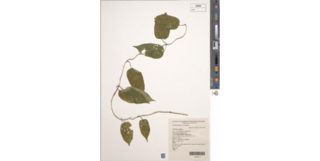
Leichhardtia australis, commonly known as the bush banana, silky pear or green vine is an Australian native plant. It is found in Central Australia and throughout Western Australia. It is a bush tucker food used by Indigenous Australians.

Marsdenia is a genus of plants in the family Apocynaceae first described as a genus in 1810. It is named in honor of the plant collector and Secretary of the Admiralty, William Marsden. The plants are native to tropical regions in Asia, Africa, Australia, and the Americas.

Calytrix is a genus of shrubs in the family Myrtaceae described as a genus in 1806. They are commonly known as starflowers. Calytrix are endemic to Australia, occurring in the.

Parsonsia is a genus of woody vines in the family Apocynaceae. Species occur throughout Indomalaya, Australasia and Melanesia.

Geitonoplesium is a monotypic genus in the family Asphodelaceae, containing the sole species Geitonoplesium cymosum, commonly known as scrambling lily. The species is a perennial evergreen scrambling vine found in rainforests, sclerophyll forests and woodlands of eastern Australia, and parts of Malesia and Melanesia.

Tricoryne is a genus of perennial herbs in the family Asphodelaceae, subfamily Hemerocallidoideae. All species are native to Australia with two species extending to New Guinea; within Australia they occur in all 6 states and the Northern Territory.
- Tricoryne ancepsR.Br. - New Guinea, Queensland
- Tricoryne corynothecoidesKeighery - Western Australia
- Tricoryne elatiorR.Br. - Yellow Rush-lily - all 6 states plus Northern Territory
- Tricoryne humilisEndl. - Western Australia
- Tricoryne muricataBaker - Queensland
- Tricoryne platypteraRchb.f - New Guinea, Queensland
- Tricoryne simplexR.Br. - New South Wales
- Tricoryne tenellaR.Br. - Mallee Rush-lily - Western Australia, South Australia
Richard Cunningham was an English botanist who became Colonial Botanist of New South Wales and superintendent of the Sydney Botanic Gardens.

Persoonia cornifolia is a plant in the family Proteaceae and is endemic to eastern Australia. It is a shrub with elliptic to egg-shaped leaves and hairy yellow flowers, and grows in northern New South Wales and south-eastern Queensland.

Acacia lanigera, commonly known as woolly wattle or hairy wattle, is a tree species that is endemic south eastern Australia.

Acacia buxifolia, commonly known as box-leaf wattle, is shrub species that is endemic to eastern Australia.

Vincetoxicum barbatum, synonym Tylophora barbata, the bearded tylophora, is a small vine in the dogbane family. A common plant found south of Bulahdelah, New South Wales. The habitat is rainforest and moist eucalyptus forests in south eastern Australia. Not often seen in flower, but flowers are dark red, around 7 mm long on thin stalks. Broken branches produce watery or milky sap.

Leichhardtia suaveolens, synonym Marsdenia suaveolens, commonly known as the scented milk vine, is a small vine found in New South Wales, Australia. It is found in a variety of habitats in relatively high rainfall areas, from Bega to Port Macquarie. The original specimen was collected at Sydney on 11 May 1802.
Milk vine is a common name for several plants and may refer to:

Acacia flavescens, also known as the red wattle, yellow wattle or primrose ball wattle, is a tree in the genus Acacia native to eastern Australia.

Leichhardtia rostrata, synonym Marsdenia rostrata, is a common climbing plant found in eastern Australia. This member of the dogbane family features white milky sap, when leaves are broken from the stem. It is found in a variety of habitats in relatively high rainfall areas, including rainforest and wet eucalyptus forest. Widespread in distribution in coastal regions, though it also appears inland in places such as the Liverpool Range. It may grow to ten metres tall, with a woody stem up to 4 cm wide. Leaves range from 4 to 13 cm long and 2 to 7 cm wide. The fruit is somewhat pear shaped, 5 cm by 2.5 cm.

Astrotricha linearis, commonly known as the narrow-leaf star-hair, is a plant species in the family Araliaceae. The species is endemic to south-east Australia. Plants grow to 1.5 metres high and have linear leaves that are 20 to 65 mm long and 1 to 1.5 mm wide. Flowers appear between October and December in the species native range.

Lordhowea velleioides, synonym Senecio velleioides, is a species of flowering plant in the family Asteraceae. It is commonly known as forest groundsel.

Parsonsia alboflavescens is a woody vine of the family Apocynaceae, found from tropical and subtropical Asia to Northern Australia. In the Northern Territory of Australia, where it occurs in Arnhem Land, it has been declared "near threatened".

Acacia asparagoides is a shrub belonging to the genus Acacia and the subgenus Phyllodineae. It is native to an area in south eastern New South Wales.

Leichhardtia liisae is a climbing plant in the Apocynaceae family, endemic to north-eastern New South Wales.



















